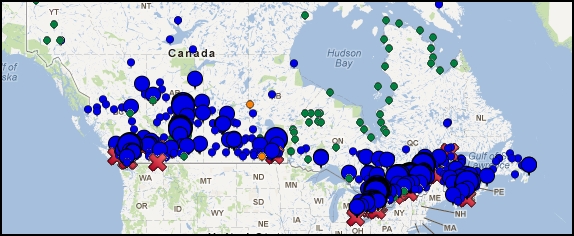cinematographic atlas
Canadian Movie Theaters Spatial Distribution
- Google Maps ("Google mashup" of Canadian Movie Theaters)
- Analyze the data Geocommons
- Download the dataset on Geocommons (KML, SHP and CSV)

In order to get coherent movie theaters data all over the Canadian territory, we turned to the Film Canada Year Book, which publishes every year a list of movie theaters and drive-in accross the country. This list has the advantage of indicating the number of rooms and seats per establishment. However, the only geographic information this list provides is the province and the city where the institution is located. More specific information about movie theaters' location had to be searched.
Cinemaclock website has proved to be particularly useful in this context, because it provides not only a list of movies playing in theaters, but also the mailing address and phone number. These details have therefore been added to the data from the Film Canada Year Book. CinemaClock list is not exhaustive though, so we used the Google search engine to obtain the addresses of missing theaters. This research has highlighted the existence of theaters that were not listed neither in the Canada Year Book and the CinemaClock database. Indeed, if large theaters owned by corporate chains are very well referenced, small theaters managed independently proved to be much more difficult to locate. This difficulty increased for theaters opened only a few seasons (eg, drive-ins) and for places where films remain a marginal activity, such as schools, concert halls, theaters, associations, community centers, independent festivals, etc. On October 5th, 2010, 758 entries were added to the database across Canada, including 625 cinemas, 28 drive-ins, and 103 others (eg, school, theater, etc.).
This database was then georeferenced from movie theaters' postal code. Canadian postal codes can be very accurate in urban areas (at the scale of a building), and roughest in rural area, where they can reach several thousands of square kilometers in the desert areas of Canadian North. Nevertheless, this bias is offset by the fact that the points representing the postal codes in rural areas are located within the main villages where are usually found movie theaters. The 758 points in the database have been georeferenced from the DMTI Spatial Postal CanMap Geography, which is a 2001 postal codes database.
For a deeper analysis of the movie theaters' spatial distribution, we suggest this article (French only):
Caquard S., Naud D., and Perichon V. 2009. "La répartition des salles obscures canadiennes: un éclairage géographique", Cahiers de géographie du Québec 53 (149): 221-241.
In the spirit of the Creative commons, data collected and created in the context of this project are available to visitors and researchers, provided that three conditions are met:
- Attribution: You must attribute the work in the manner specified by the author or licensor (but not in any way that suggests that they endorse you or your use of the work).
- Noncommercial : You may not use this work for commercial purposes.
- Share Alike: If you alter, transform, or build upon this work, you may distribute the resulting work only under the same or similar license to this one.
